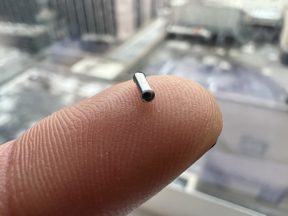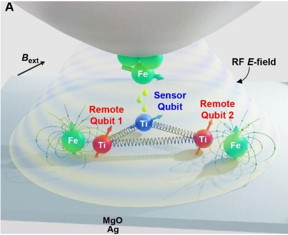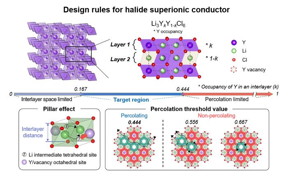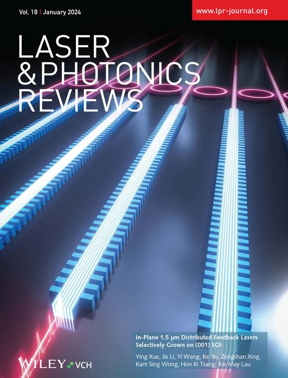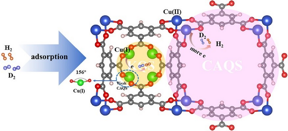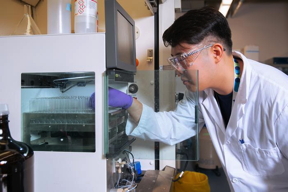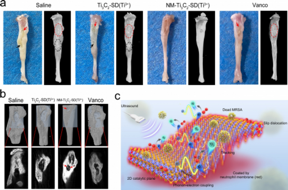Home > Press > Nanoparticle quasicrystal constructed with DNA: The breakthrough opens the way for designing and building more complex structures
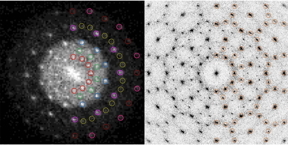 |
| A mathematical tool called a fast Fourier transform maps the structure in a way that reveals the 12-fold symmetry of the quasicrystal. The fast Fourier transform of the electron microscope image of the quasicrystal is shown on the left, while the transform of the simulated crystal is shown on the right. Credit: Mirkin Research Group, Northwestern University, and Glotzer Group, University of Michigan. |
Abstract:
Nanoengineers have created a quasicrystal—a scientifically intriguing and technologically promising material structure—from nanoparticles using DNA, the molecule that encodes life.
Nanoparticle quasicrystal constructed with DNA: The breakthrough opens the way for designing and building more complex structures
Ann Arbor, MI | Posted on November 3rd, 2023
The team, led by researchers at Northwestern University, the University of Michigan and the Center for Cooperative Research in Biomaterials in San Sebastian, Spain, reports the results in Nature Materials.
Unlike ordinary crystals, which are defined by a repeating structure, the patterns in quasicrystals don’t repeat. Quasicrystals built from atoms can have exceptional properties—for example, absorbing heat and light differently, exhibiting unusual electronic properties such as conducting electricity without resistance, or their surfaces are very hard or very slippery.
Engineers studying nanoscale assembly often view nanoparticles as a kind of ‘designer atom,’ which provides a new level of control over synthetic materials. One of the challenges is directing particles to assemble into desired structures with useful qualities, and in building this first DNA-assembled quasicrystal, the team entered a new frontier in nanomaterial design.
“The existence of quasicrystals has been a puzzle for decades, and their discovery appropriately was awarded with a Nobel Prize,” said Chad Mirkin, the George B. Rathmann Professor of Chemistry at Northwestern University and co-corresponding author of the study. “Although there are now several known examples, discovered in nature or through serendipitous routes, our research demystifies their formation and more importantly shows how we can harness the programmable nature of DNA to design and assemble quasicrystals deliberately.”
Mirkin’s group is known for using DNA as a designer glue to engineer the formation of colloidal crystals made of nanoparticles, and the group of Luis Liz-Marzán, the Ikerbasque Professor at the Spanish Center for Cooperative Research in Biomaterials, could produce nanoparticles that might form quasicrystals under the right conditions. The team focused on bipyramidal shapes—basically two pyramids stuck together at their bases. Liz-Marzán’s group tried different numbers of sides as well as squashing and stretching the shapes. Wenjie Zhou and Haixin Lin, doctoral students in chemistry at Northwestern at the time of the work, used DNA strands encoded to recognize one another to program the particles to assemble into a quasicrystal.
Independently, the group of Sharon Glotzer, the Anthony C. Lembke Chair of Chemical Engineering at U-M, had been simulating bipyramids with different numbers of sides. Yein Lim and Sangmin Lee, doctoral students in chemical engineering at U-M, found that decahedra—10-sided pentagonal bipyramids—would form a quasicrystal under certain conditions, and with the right relative dimensions.
In 2009, Glotzer’s team had predicted the first layered nanoparticle quasicrystal, not from bipyramids but from tetrahedra—single pyramids with four triangular sides like a D4 die. Because five tetrahedra can nearly make a type of decahedron, she says that the decahedron was a savvy choice for making a quasicrystal.
“In our original quasicrystal simulation, the tetrahedra arranged into decahedra with very small gaps between the tetrahedra. Here, those gaps would be filled by DNA, so it made sense that decahedra might make quasicrystals, too,” said Glotzer, co-corresponding author of the study.
Through a combination of theory and experiment, the three research groups made the decahedron particles into a quasicrystal, which was confirmed by electron microscope imaging at Northwestern and X-ray scattering done at Argonne National Laboratory.
“Through the successful engineering of colloidal quasicrystals, we have achieved a significant milestone in the realm of nanoscience,” said Liz-Marzán, co-corresponding author of the study. “Our work not only sheds light on the design and creation of intricate nanoscale structures but also opens a world of possibilities for advanced materials and innovative nanotechnology applications.”
The structure resembles an array of rosettes in concentric circles, the 10-sided shapes creating a 12-fold symmetry in 2D layers that stack periodically. This stacked structure, also seen with quasicrystals made from tetrahedra, is called an axial quasicrystal. But unlike most axial quasicrystals, the tiling pattern of the new quasicrystal’s layers do not repeat identically from one layer to the next. Instead, a significant percentage of tiles are different, in a random way—and this small amount of disorder adds stability.
The research is funded by the US Air Force Office of Scientific Research and the US Department of Energy, Spanish Ministry of Science and Innovation, and the Maria de Maeztu Units of Excellence Program from the Spanish State Research Agency. The project also relied on resources at the Extreme Science and Engineering Discovery Environment, NUANCE at Northwestern University and computational resources at U-M.
Glotzer is also the John Werner Cahn Distinguished University Professor of Engineering and Stuart W. Churchill Collegiate Professor of Chemical Engineering.
Written in collaboration with Seth Zimmerman
####
For more information, please click here
Contacts:
Katherine McAlpine
University of Michigan
Copyright © University of Michigan
If you have a comment, please Contact us.
Issuers of news releases, not 7th Wave, Inc. or Nanotechnology Now, are solely responsible for the accuracy of the content.
| Related Links |
![]() Study: Colloidal quasicrystals engineered with DNA (DOI: 10.1038/s41563-023-01706-x):
Study: Colloidal quasicrystals engineered with DNA (DOI: 10.1038/s41563-023-01706-x):
| Related News Press |
News and information
![]() What a “2D” quantum superfluid feels like to the touch November 3rd, 2023
What a “2D” quantum superfluid feels like to the touch November 3rd, 2023
2 Dimensional Materials
Govt.-Legislation/Regulation/Funding/Policy
![]() Quantum powers researchers to see the unseen September 8th, 2023
Quantum powers researchers to see the unseen September 8th, 2023
![]() Chloride ions from seawater eyed as possible lithium replacement in batteries of the future August 11th, 2023
Chloride ions from seawater eyed as possible lithium replacement in batteries of the future August 11th, 2023
![]() Tattoo technique transfers gold nanopatterns onto live cells August 11th, 2023
Tattoo technique transfers gold nanopatterns onto live cells August 11th, 2023
Possible Futures
![]() Light guide plate based on perovskite nanocomposites November 3rd, 2023
Light guide plate based on perovskite nanocomposites November 3rd, 2023
![]() Charged “molecular beasts” the basis for new compounds: Researchers at Leipzig University use “aggressive” fragments of molecular ions for chemical synthesis November 3rd, 2023
Charged “molecular beasts” the basis for new compounds: Researchers at Leipzig University use “aggressive” fragments of molecular ions for chemical synthesis November 3rd, 2023
![]() Study on Magnetic Force Microscopy wins 2023 Advances in Magnetism Award: Analysis of finite size effects reveals significant consequences for density measurements November 3rd, 2023
Study on Magnetic Force Microscopy wins 2023 Advances in Magnetism Award: Analysis of finite size effects reveals significant consequences for density measurements November 3rd, 2023
![]() Ferroelectrically modulate the Fermi level of graphene oxide to enhance SERS response November 3rd, 2023
Ferroelectrically modulate the Fermi level of graphene oxide to enhance SERS response November 3rd, 2023
Discoveries
![]() What a “2D” quantum superfluid feels like to the touch November 3rd, 2023
What a “2D” quantum superfluid feels like to the touch November 3rd, 2023
Materials/Metamaterials/Magnetoresistance
![]() Ferroelectrically modulate the Fermi level of graphene oxide to enhance SERS response November 3rd, 2023
Ferroelectrically modulate the Fermi level of graphene oxide to enhance SERS response November 3rd, 2023
![]() Ultrafast lasers for materials processing August 11th, 2023
Ultrafast lasers for materials processing August 11th, 2023
![]() Researchers put a new twist on graphite July 21st, 2023
Researchers put a new twist on graphite July 21st, 2023
Announcements
![]() Light guide plate based on perovskite nanocomposites November 3rd, 2023
Light guide plate based on perovskite nanocomposites November 3rd, 2023
![]() Charged “molecular beasts” the basis for new compounds: Researchers at Leipzig University use “aggressive” fragments of molecular ions for chemical synthesis November 3rd, 2023
Charged “molecular beasts” the basis for new compounds: Researchers at Leipzig University use “aggressive” fragments of molecular ions for chemical synthesis November 3rd, 2023
![]() Study on Magnetic Force Microscopy wins 2023 Advances in Magnetism Award: Analysis of finite size effects reveals significant consequences for density measurements November 3rd, 2023
Study on Magnetic Force Microscopy wins 2023 Advances in Magnetism Award: Analysis of finite size effects reveals significant consequences for density measurements November 3rd, 2023
![]() Ferroelectrically modulate the Fermi level of graphene oxide to enhance SERS response November 3rd, 2023
Ferroelectrically modulate the Fermi level of graphene oxide to enhance SERS response November 3rd, 2023
Interviews/Book Reviews/Essays/Reports/Podcasts/Journals/White papers/Posters
![]() What a “2D” quantum superfluid feels like to the touch November 3rd, 2023
What a “2D” quantum superfluid feels like to the touch November 3rd, 2023
Military
![]() Quantum powers researchers to see the unseen September 8th, 2023
Quantum powers researchers to see the unseen September 8th, 2023
![]() The picture of health: Virginia Tech researchers enhance bioimaging and sensing with quantum photonics June 30th, 2023
The picture of health: Virginia Tech researchers enhance bioimaging and sensing with quantum photonics June 30th, 2023
Research partnerships
![]() Electronic detection of DNA nanoballs enables simple pathogen detection Peer-Reviewed Publication September 8th, 2023
Electronic detection of DNA nanoballs enables simple pathogen detection Peer-Reviewed Publication September 8th, 2023
![]() Polymer p-doping improves perovskite solar cell stability January 20th, 2023
Polymer p-doping improves perovskite solar cell stability January 20th, 2023
- SEO Powered Content & PR Distribution. Get Amplified Today.
- PlatoData.Network Vertical Generative Ai. Empower Yourself. Access Here.
- PlatoAiStream. Web3 Intelligence. Knowledge Amplified. Access Here.
- PlatoESG. Carbon, CleanTech, Energy, Environment, Solar, Waste Management. Access Here.
- PlatoHealth. Biotech and Clinical Trials Intelligence. Access Here.
- Source: http://www.nanotech-now.com/news.cgi?story_id=57409
- :has
- :is
- :not
- 10
- 12th
- 2009
- 2023
- 20th
- 21st
- 29
- 2D
- 2D materials
- 30th
- 3rd
- 7th
- 8th
- 9
- a
- accuracy
- Achieve
- achieved
- Adds
- advanced
- Advanced materials
- advances
- agency
- AIR
- Air Force
- also
- Although
- amount
- an
- analysis
- and
- Another
- Anthony
- applications
- appropriately
- April
- ARE
- Argonne National Laboratory
- arranged
- Array
- AS
- Assembly
- At
- atom
- AUGUST
- author
- award
- awarded
- b
- based
- basis
- batteries
- battery
- BE
- because
- been
- between
- Biomaterials
- boasts
- breakthrough
- brown
- Brown University
- Building
- built
- bulletproof
- but
- by
- called
- CAN
- candidate
- cell
- Center
- certain
- CGI
- Chair
- challenges
- chemical
- chemistry
- chip
- choice
- circles
- click
- collaboration
- Columbia
- COM
- combination
- comment
- commercialisation
- complex
- computational
- conditions
- conducting
- CONFIRMED
- Consequences
- content
- control
- cooperative
- Cost
- cost-effective
- could
- created
- Creating
- creation
- credit
- Crystal
- de
- deal
- decades
- Decline
- defined
- del
- demystifies
- density
- Department
- Department of Energy
- Design
- Designer
- designing
- designs
- desired
- Detection
- developed
- Die
- different
- dimensions
- directing
- discover
- discovered
- discovery
- disorder
- Distinguished
- dna
- do
- doesn
- don
- done
- Edge
- effects
- electricity
- electrolytes
- Electronic
- enables
- end
- energy
- engineer
- engineered
- Engineering
- enhance
- entered
- Environment
- Ether (ETH)
- evaluation
- example
- examples
- Excellence
- exceptional
- Exhibiting
- existence
- expected
- experiment
- experimental
- Explain
- extreme
- FAST
- fibers
- field
- filled
- First
- first time
- five
- focused
- For
- Force
- form
- formation
- found
- four
- from
- Frontier
- funded
- future
- gaps
- George
- gif
- Global
- Gold
- Graphene
- greater
- Group
- Group’s
- guide
- had
- Hard
- harness
- Have
- Health
- help
- here
- High
- How
- http
- HTTPS
- if
- image
- Imaging
- importantly
- improvements
- improves
- in
- Inc.
- industry
- information
- Innovation
- innovative
- instead
- into
- intricate
- intriguing
- IT
- ITS
- January
- John
- jpg
- July
- june
- just
- Kind
- known
- laboratory
- landmark
- lasers
- layer
- layered
- layers
- Led
- Lee
- left
- Level
- Life
- light
- like
- lin
- links
- lithium
- live
- Long
- long-standing
- Low
- made
- Magnetism
- make
- Making
- Maps
- March
- maria
- material
- materials
- mathematical
- May..
- mechanism
- metal
- method
- Michigan
- Microscope
- Microscopy
- might
- milestone
- ministry
- molecular
- molecule
- monumental
- more
- most
- nanotechnology
- National
- Natural
- Nature
- nearly
- net
- New
- newly
- news
- next
- next-generation
- nobel
- nobel prize
- Northwestern University
- November
- now
- Nuance
- numbers
- observing
- of
- Offers
- Office
- often
- on
- ONE
- only
- onto
- opens
- optical
- or
- ordinary
- original
- our
- over
- pathway
- Pattern
- patterns
- pave
- peer-reviewed
- percentage
- performance
- PHP
- picture
- plato
- Plato Data Intelligence
- PlatoData
- please
- possibilities
- possible
- Post
- posted
- potential
- powers
- predicted
- press
- Press Release
- prize
- probe
- processing
- produce
- Professor
- Program
- programmable
- project
- promising
- properties
- provides
- Push
- put
- puzzle
- qualities
- Quantum
- random
- rapid
- reaction
- realm
- recognize
- relative
- release
- Releases
- Renowned
- repeat
- replacement
- Reports
- research
- research group
- researchers
- resembles
- Resistance
- Resources
- responsible
- Results
- return
- Reveals
- revolutionize
- right
- Rival
- Room
- routes
- s
- Said
- San
- Save
- savvy
- says
- scalable
- Science
- scientific
- Scientific Research
- scientists
- Search
- see
- seen
- sense
- sensors
- September
- several
- shapes
- Share
- she
- shown
- Shows
- Sides
- significant
- Signs
- Simple
- simulation
- simulations
- Size
- small
- So
- solar
- solely
- Soon
- Source
- Spain
- Spanish
- Spin
- Stability
- stack
- stacked
- start
- State
- Strands
- strength
- strong
- structure
- structures
- Students
- Study
- Studying
- submit
- successful
- such
- Superconductivity
- Sustainability
- synthetic
- system
- T
- tackle
- team
- tech
- technique
- than
- that
- The
- their
- theory
- There.
- this
- those
- three
- Through
- time
- times
- to
- together
- too
- tool
- toward
- transfers
- Transform
- transitions
- tried
- twist
- two
- type
- Ultra
- under
- units
- university
- University of Michigan
- unknown
- unlike
- unusual
- us
- use
- used
- useful
- using
- very
- View
- virginia
- W
- was
- Wave
- Way..
- we
- WELL
- which
- while
- Wins
- with
- without
- Work
- world
- would
- x-ray
- Yahoo
- Yield
- you
- zephyrnet











